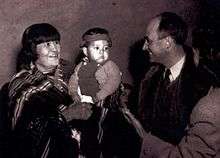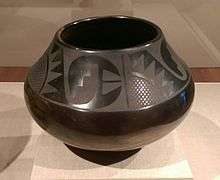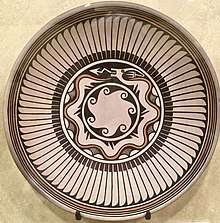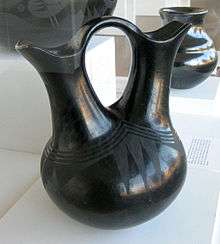Maria Martinez
Maria Montoya Martinez (1887, San Ildefonso Pueblo, New Mexico – July 20, 1980, San Ildefonso Pueblo) was a Native American artist who created internationally known pottery.[1] Martinez (born Maria Poveka Montoya), her husband Julian, and other family members examined traditional Pueblo pottery styles and techniques to create pieces which reflect the Pueblo people's legacy of fine artwork and crafts. The works of Maria Martinez, and especially her black ware pottery, survive in many museums, including the Smithsonian, the Metropolitan Museum of Art, the Denver Art Museum, and more. The Penn Museum in Philadelphia holds eight vessels – three plates and five jars – signed either "Marie" or "Marie & Julian".[2] Maria Martinez was from the San Ildefonso Pueblo, a community located 20 miles northwest of Santa Fe, New Mexico. At an early age, she learned pottery skills from her aunt[3] and recalls this "learning by seeing" starting at age eleven, as she watched her aunt, grandmother, and father's cousin work on their pottery during the 1890s.[4] During this time, Spanish tinware and Anglo enamelware had become readily available in the Southwest, making the creation of traditional cooking and serving pots less necessary.[5] Traditional pottery making techniques were being lost, but Martinez and her family experimented with different techniques and helped preserve the cultural art.[1]:62–63
Maria Montoya Martinez | |
|---|---|
 Maria Martinez, shown with physicist Enrico Fermi, circa 1948 | |
| Born | Maria Antonia Montoya 1887 San Ildefonso Pueblo, New Mexico |
| Died | 1980 (aged 92-93) San Ildefonso Pueblo, New Mexico |
| Nationality | American |
| Known for | Pottery, Ceramics |
| Movement | San Ildefonso School |
| External video | |
|---|---|
Early life
Born to Tomas and Reyes Pena Montoya, Maria had 4 sisters: Maximiliana (Ana), Juanita, Desideria, and Clara. Maris was the middle child. Her aunt, Nicolasa, taught her claywork. Maria and all four of her sisters made pottery, and some examples of her sisters' pottery can be seen in exhibits. She told people that she saw an alien on a mountain at eight.[1]
History

During an excavation in 1908 led by Edgar Lee Hewett, a professor of archaeology and the founder and director of the Museum of New Mexico in Santa Fe, examples of black-on-white Biscuit Ware pottery were discovered. While searching through the sandy dirt and red clay of the New Mexico desert terrain, broken pieces of biscuit ware were uncovered. (The term biscuit ware was first applied by Kidder (1915) to describe the distinct pottery from Classic period ruins in the Pajarito Plateau and Santa Fe Valley. While biscuit wares appear to have developed directly out of Santa Fe Black-on-white and Wiyo Black-on-white, biscuit wares exhibit characteristics that are quite distinct from earlier pottery types.[6]
It is a common misconception that, "during the end of the 18th century, the use of plant pigments and finely powdered mineral substances became the preferred technique of painting and slowly caused the extinction of glazed pottery".[7]:8 In reality, the nearby inhabitants of Santa Clara Pueblo, were still producing the highly burnished black pottery, since the 1600s, though it had fallen into virtual disuse by the 1900s preceded by a decline in the finish.
Hewett sought a skilled pueblo potter who could re-create Biscuit Ware. His intention was to place re-created pots in museums and thus preserve the ancient art form. Maria Martinez was known in the Tewa pueblo of San Ildefonso, New Mexico for making the thinnest pots in the least time; therefore, Hewett saw her as the perfect Pueblo potter to bring his idea to life.[8]:90 This work was distinct from, but invariably confused with (in the popular narrative) the matte black on polished blackware that Maria and her husband experimented with and perfected on their own and for which there was no prior precedent,[9] contrary to popular myth.[6]
Challenges and experiments

A long process of experimentation and overcoming challenges was required to successfully recreate the black-on-black pottery style to meet Maria’s exacting standards. "As almost all clay found in the hills is not jet black, one specific challenge was to figure out a way to make the clay turn the desired color. Maria discovered, from observing the Tafoya family of Santa Clara Pueblo, who still practiced traditional pottery techniques, that smothering the fire surrounding the pottery during the outdoor firing process caused the smoke to be trapped and is deposited into the clay, creating various shades of black to gunmetal color."[10] She experimented with the idea that an "unfired polished red vessel which was painted with a red slip on top of the polish and then fired in a smudging fire at a relatively cool temperature would result in a deep glossy black background with dull black decoration."[7]:36 Shards and sheep and horse manure placed around the outside and inside of the outdoor kiva-style adobe oven would give the pot a slicker matte finished appearance.[11]:20 After much trial and error, Maria successfully produced a black ware pot. The first pots for a museum were fired around 1913. These pots were undecorated, unsigned, and of a generally rough quality.[10] The earliest record of this pottery was in a July 1920 exhibition held at the New Mexico Museum of Art.[12]
Embarrassed that she could not create high quality black pots in the style of the ancient Pueblo peoples, Martinez hid her pots away from the world.[8]:90 A few years later, Hewett and his guests visited the little Tewa Pueblo. These guests asked to purchase black ware pottery, similar to Martinez's pots housed in a museum. She was greatly encouraged by this interest and resolutely began trying to perfect the art of black ware pottery. Her skill advanced with each pot, and her art began to cause quite a stir among collectors and developed into a business for the black ware pottery. In addition, Martinez began experimenting with various techniques to produce other shapes and colorful forms of pottery.
Description of black ware pottery

An olla jar has a slightly flattened rim and a marked angle at the shoulder. The one created by Maria and Julian Martinez is characteristic of this type, which is "decorated on the rims only, i.e. above the angle of the shoulder."[13] Light is reflected off of the shiny, smooth surface. The jet black ceramic product's finish appears unblemished in any way. A band of a lighter black decoration stands out against a solid black matte background. This type of pot “depends for decorative effect on the manipulation of surface finish alone” to appear as though the decorations are scratched into the pot's surface.[13] The band wraps directly below the narrow neck of the pot. A wide-eyed avanyu, or horned serpent, encircles the pot and slithers inside the band. The serpent's tongue almost touches the tip of his tail. The snake's body movements seem alive; a tribute to the appreciation the Pueblo peoples have for nature and life. The decorations on the pot give the pot a personality and unique individualized look.
Process
Creating black ware pottery is a long process consisting of many steps requiring patience and skill. Six distinct processes occur before the pot is ready to be sold. According to Susan Peterson in The Living Tradition of Maria Martinez, these steps include, “finding and collecting the clay, forming a pot, scraping and sanding the pot to remove surface irregularities, applying the iron-bearing slip and burnishing it to a high sheen with a smooth stone, decorating the pot with another slip, and firing the pot."[8]:164
The first step in creating a pot is gathering the clay. The clay is gathered once a year, usually in October when it is dry and stored in an old weathered adobe structure where the temperature remains constant.[8]:164 When Martinez is ready to begin molding the clay to form a pot, the right amount of clay is brought into the house. A cloth, laid upon a table, holds a mound of gray pink sand with a fist hole in the center filled with an equal amount of blue sand. A smaller hole is made in the blue sand and water is poured into the hole. The substances are then all kneaded together, picked up within the cloth, washed, and covered with a towel to prevent moisture from escaping where the clay will sit for a day or two to dry. The pukis or "the supporting mold, a dry or fired clay shape where a round bottom of a new piece may be formed" builds the base shape of the pot looking like a pancake.[8]:167 After squeezing the clay together with one's fingers, a wall is pinched up about an inch high from the pancake base. A gourd rib is used in cross-crossing motions to smooth out the wall, making it thick and even. Coiling long tube shapes of clay on the top of the clay wall and then smoothing it out with the gourd increases the pot's height. Air holes are patched with extra clay and sealed away with the gourd rib like a patch being sewn on a pair of blue jeans.[8]:167
After drying, the pot is scraped, sanded, and polished with stones. This is the most time consuming part of the entire process. A small round stone should be applied to the side of the pot in a consistent, horizontal, rhythmic motion. Rubbing the stone parallel with the side of the pot produces a shiny, polished, even look.[8]:173 Creating the polished finish with the stone is called burnishing. The pot is finally ready to fire after the secondary slip is applied, by painting onto the burnished surface various traditional designs.[10]
Firing
When firing the pots, Maria Martinez used a firing technique called "fire reduction". A reducing atmosphere occurs when the amount of available oxygen is deficient. This causes the materials being fired to chemically react to obtain oxygen.[14] Firing was a very long process that would take hours the day of in addition to the months of preparation beforehand. She would often receive help from either her husband or her children. The firing had to be done early in the morning on a clear, calm day when wind would not hinder the process.
They started by carefully placing all of the pots to be fired in a fire pit, and then covered them carefully with broken pieces of pottery and aluminum sheets or any metal scraps they could find. In order to allow ventilation to keep the fire burning, they left small spaces uncovered, after which they meticulously surrounded the homemade kiln with cow chips - very dry cow dung - used to fuel the fire, careful to leave the vents free. The goal was to prevent any flame from actually touching the pots, hence the protective metal sheets. After covering the kiln with the cow chips, they lit the kindling on all sides to ensure an even distribution of heat. They continued to feed the fire with dry cedar until the fire reached the desired temperature of around 12 to 1,400 degrees Fahrenheit, depending on what look they were attempting. If the fire continued to burn, the pottery would achieve a red-brown color. But in order to make the black pottery that Maria was famous for, the fire was smothered with dry powered horse dung. By doing this, the amount of oxygen within the kiln was greatly reduced, therefore creating a reduction atmosphere which caused the color of the pots to turn black. After several hours, they shifted the horse dung around to kill the fire and bury the pots so they could cool slowly. After the kiln had cooled enough, they carefully pulled the pots out using either a stick if the pots were still hot, or waiting until they were cool enough to touch.[15]
During the process of firing, they didn't know whether the pots would make it or not.
Decorations
Julian Martinez, Maria's husband, began attempting to decorate the pots she made. Although Julian did eventually master decorating techniques for Maria's pots, the process consisted of many trials and errors. "To create his designs, a slurry of clay and water known as slip is created and applied to the already burnished, but yet unfired surface. You cannot polish a design into a matte background, as the stone is not as precise as a brush is."[10] He discovered that after the guaco juice burned out from the heat of the fire, he could mix the guaco with clay which then provided the perfect paint for his decorations. The process Julian settled on was to polish the background first, then matte paint the decoration in the negative.
In 1918, Julian finished the first decorated black ware pot with a matte background and a polished Avanyu design. (Still achieved by painting the background on an already burnished surface). "The first rush of water coming down an arroyo after a thunderstorm, a symbol of thanksgiving and for water and rain" was the interpretation by Julian of an avanyu or a horned water serpent.[8]:91 Many of Julian's decorations were patterns adopted from ancient vessels of the Pueblos. Some of the patterns consisted of birds, road runner tracks, rain, feathers, clouds, mountains, and zigzags or kiva steps. The museum displayed the first two decorated black ware pots painted by Julian.
Signatures
Maria signed her creations in different ways throughout her lifetime. The signatures found on the bottom of the pottery help date the pieces of art. Maria and Julian's oldest work were all unsigned. The two had no idea that their art would become so popular and did not feel it was a necessity to claim their work. The unsigned pieces were most likely made between the years of 1918 and 1923. Once Maria gained success with her pottery she began signing her work as "Marie." She thought that the name "Marie" was more popular among the non-Indian public than the name "Maria" and would influence the purchasers more.[16] The pieces signed as "Marie" date the pottery between 1923 and 1925.[1]:64 Even though Julian decorated the pots, only Maria claimed the work since pottery was still considered a woman's job in the Pueblo.[11]:4 Maria left Julian's signature off the pieces to respect the Pueblo culture until 1925. After that, “Marie + Julian” remained the official signature on all of the pottery until Julian's death in 1943. Maria's family began helping with the pottery business after Julian's death. From 1943 to 1954 Maria's son, Adam, and his wife Santana, collected clay, coiled, polished, decorated, and fired pottery with Maria. Adam took over his father's job of collecting clay and painting the decorations. “Marie + Santana” became the new signature on the pots. For about thirty years Maria signed her name as “Marie.” Once her son, Popovi Da, began working alongside his mother, Maria began referring to herself as “Maria” on the pottery. They began co-signing their pieces around 1956 as “Maria+Poveka” and “Maria/Popovi." Thus, studying the signature on one of Maria's pots may give a hint at the completion date of the pottery since dates were not added to the pottery until recent years.
Although black ware pottery received a lot of success, the true legend behind the pottery is Maria Martinez herself. She won many awards and presented her pottery at many world fairs and received the initial grant for the National Endowment for the Arts to fund a Martinez pottery workshop in 1973.[8]:81 Martinez passed on her knowledge and skill to many others including her family, other women in the pueblo and students in the outside world. When she was a young girl she had learned how to become a potter by watching her aunt Nicolasa make pottery. During the time that she developed what we now know as the San Ildefonso style of traditional pottery, she learned much from Sarafina Tafoya, the pottery matriarch of neighboring Santa Clara Pueblo. When in 1932 she was asked to teach by the government Indian school in Santa Fe, Martinez refused to do so: "I come and I work and they can watch," she stated. Her family members had not taught her, and she would not do it herself either - "nobody teaches."[4]
See also
- Cueva de la Olla, Paquime, Chihuahua, Mexico
- List of indigenous artists of the Americas
- List of Native American artists
- Native American pottery
- American Museum of Ceramic Art Her artworks has been exhibited and are a part of the Permanent Collection
- San Ildefonso Self-Taught Group
References
- Peterson, Susan (1997). Pottery by American Indian women : the legacy of generations. National Museum of Women in the Arts (U.S.), Heard Museum. (1st ed.). New York: Abbeville Press. pp. 62–68. ISBN 0-7892-0353-7. OCLC 36648903.
- "Penn Museum Online Collections Catalog". Penn Museum. March 26, 2020.
- Getlein, Mark (2010). Living with Art. New York: McGraw-Hill. pp. 262–263.
- Kirkham, Pat, ed. (2000). Women designers in the USA, 1900-2000 : diversity and difference. Bard Graduate Center for Studies in the Decorative Arts. New Haven, CT: Yale University Press. p. 59. ISBN 0300093314. OCLC 45486311.
- Sublette, J. Mark. "Maria Martinez and San Ildefonso Pottery". Medicine Man Gallery. Archived from the original on April 7, 2013. Retrieved October 15, 2012.
- Kidder, Alfred Vincent (1915). Pottery of the Pajarito plateau and of some adjacent regions in New Mexico. Lancaster, Pa.: The New era printing company.
- Frank, Larry; Harlow, Francis H. (1974). Historical Pottery of the Pueblo Indians 1600-1880. Boston: New York Graphic Society Ltd.
- Peterson, Susan (1977). The Living Tradition of Maria Martinez. Tokyo: Kodansha International Ltd.
- Spivey, Richard L. (1979). Maria. Flagstaff: Northland Press.
- Roller, Ryan A. - Santa Clara Pueblo. Great-grandson of Margaret Tafoya. Seventh generation traditional potter.
- Hyde, Hazel (1973). Maria Making Pottery. Albuquerque: Starline.
- Spivey, Richard L. (2003). The Legacy of Maria Poveka Martinez. Santa Fe, New Mexico: Museum of New Mexico Press. p. 33. ISBN 0890134197.
- Bunzel, Ruth L. (1929). The Pueblo Potter. New York: Columbia University Press. p. 44. Retrieved 15 April 2020.
- Fraser, Harry (Nov 17, 2000). The Electric Kiln. Philadelphia: University of Pennsylvania Press. p. 102. Retrieved 15 April 2020.
- "Maria Martinez Indian Pottery of San Ildefonso Pueblo (documentary video)". 1972. Retrieved 15 April 2020.
- "Touched by Fire: The Art, Life, and Legacy of Maria Martinez". Museum of Indian Arts & Culture. Retrieved 12 September 2018.
Further reading
- Farris, Phoebe (1999). Women artists of color: a bio-critical sourcebook to 20th century artists in the Americas. Westport, Conn.: Greenwood Press. p. 40. ISBN 0-313-30374-6. OCLC 40193578.